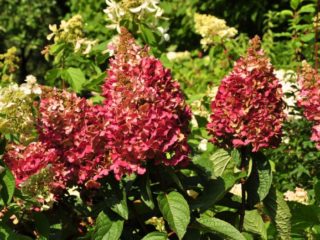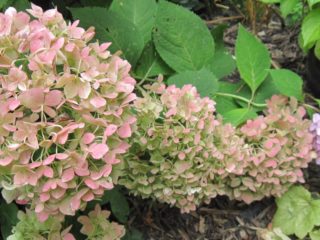Content
Hydrangea tree-like Pink Pinkushen belongs to shrubs. Attractive appearance and frost resistance make it popular in landscape design. It is important to plant the shrub correctly and arrange for proper care, including protection from diseases and pests.
Characteristics of Pink Pinkushen hydrangea
In Latin, this tree-like hydrangea variety is called Hydrangea arborescens Pink Pincushion. It grows in the form of a lush, spreading hemispherical bush. The main characteristics of the tree hydrangea are:
- average height 1-1.2 m;
- width is similar to height, but can exceed it (usually up to 1.5 m);
- many shoots that are slightly pubescent;
- the formation of inflorescences only on the shoots of this year;
- inflorescences are flat, dome-shaped, diameter 10 cm (can reach 15 cm), length 30-35 cm;
- flowering occurs in June-August, begins in the year of planting, often lasts all September;
- the color of the petals changes - at the beginning of flowering it is pink, at the end it is white and lilac-pink;
- the leaves have an elliptical or ovoid shape, diameter 8-15 cm, the edges are serrated, there is a heart-shaped notch at the base, the color changes from green to yellow-green in autumn.
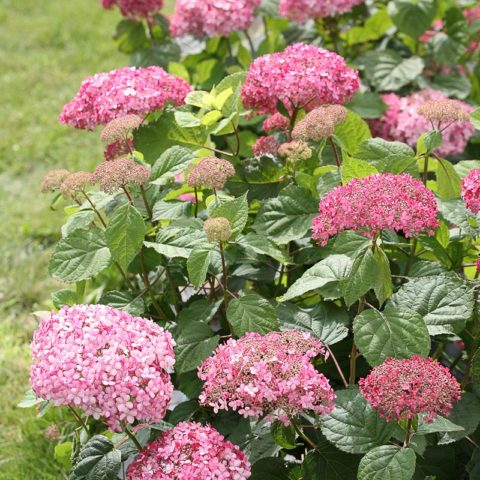
The domed shape of the inflorescences distinguishes Pink Pinkushen from the paniculate varieties of this species.
Hydrangea tree-like Pink Pincushion in landscape design
This plant is used for single and group plantings. It can be found in summer cottages, gardens, public parks.
When planting several treelike hydrangeas together, the beauty of their inflorescences is better revealed. A single plant looks good surrounded by spirea, sheared boxwood or conifers.
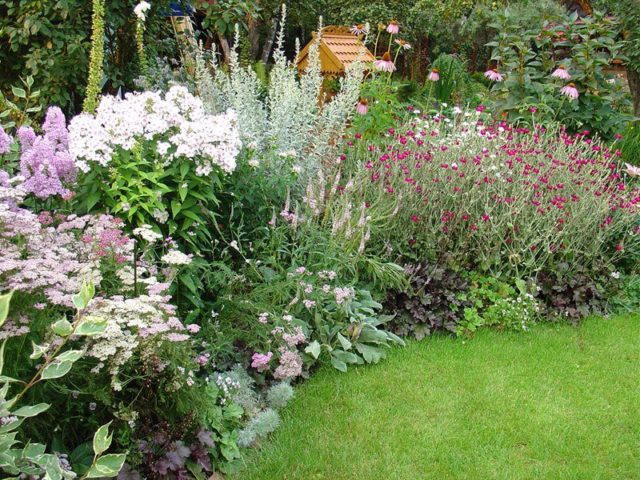
Pink Pinkushen can become the basis of a mixborder - a flower garden of perennial plants
This variety is suitable for creating hedges, edging paths.
Winter hardiness of hydrangea tree-like Pink Pinkushen
The breeders worked hard on the frost resistance of Pink Pinkushen, since the first varieties of the plant did not have this quality. This treelike hydrangea can survive freezing temperatures down to -25-29 ° C.
If the winter is harsh, then Pink Pinkushen may freeze over. The advantage of this variety is that it grows back quickly in the future.
Planting and caring for hydrangea
It is important for a plant to choose the right place and competently organize complex care. The development and health of a tree hydrangea, its life span, and attractiveness depend on this.
Selection and preparation of the landing site
When choosing a site for planting Pink Pinkushen, it is important to observe the following conditions:
- acidic soil, the optimal acidity level is pH 5;
- tree hydrangea does not like calcareous and sandy soils;
- the land must be moist and fertile;
- there should be no trees nearby that absorb a lot of moisture.
- when planting in the southern region, it is better to choose partial shade, and in the north or in the middle lane - a well-lit or slightly shaded place;
- the best option is when the sun's rays hit Pink Pinkushen in the morning and evening, and in the afternoon the plant is in the shade.
It is important for the tree hydrangea to prepare the right soil. The best option is to take 2 parts of leafy earth and humus, 1 part of peat and sand.
Plant Pink Pinkushen as follows:
- Prepare the landing pit. This is done a few days before planting. It is optimal to make the width, length and depth of 30 cm.
- Add humus and peat to the planting hole - 1/3 of a bucket per bush.
- Loosen the soil before planting.
- Place the hydrangea vertically, sprinkle with soil. The root collar should not be buried, but may be at ground level.
- Water the bush with soft water.
- Gently loosen the soil.
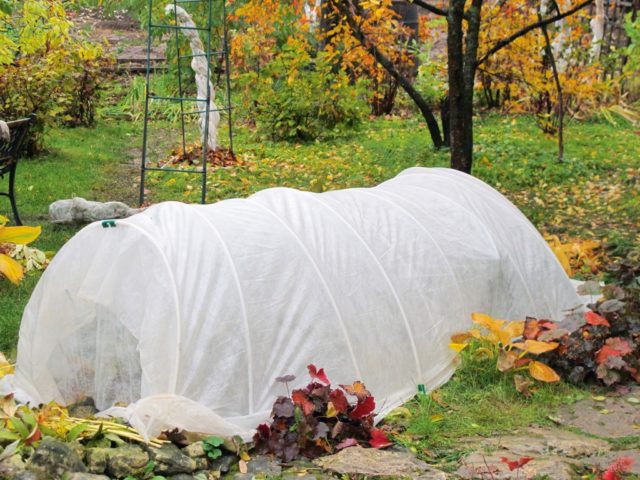
Instead of hay, you can use agrofibre, if a lot of snow falls in the region, then the construction of a metal frame over the crown will help protect the branches
Landing rules
When planning to plant Pink Pinkushen, you need to remember the following rules:
- Planting should be done in the spring. In autumn, it is allowed only in the southern regions.
- When it is important to plant, try to keep the earthy lump.
- A distance of at least 1 m is left between the plants.
Watering and feeding
Pink Pinkushen cannot stand drought. Water the tree hydrangea regularly. In summer drought, watering should be increased, it is carried out every 3-4 days. For adult plants, you need 15-20 liters of water per bush. During the rainy season, hydration is required once a month.
After watering, the soil should be loosened. This is important for aerating the soil, so the roots will receive enough important oxygen.
It is necessary to get rid of faded inflorescences. Such a measure stimulates the formation of new buds, serves as the prevention of certain diseases, and provides an aesthetic appearance.
An important point in the care of the Pink Pinkushen tree hydrangea is feeding. They are carried out according to the following scheme:
- At the beginning of spring, the shrub grows, therefore, nitrogen fertilization with potassium and phosphorus is required, such additives should be insignificant. For quick assimilation of elements, you can use a liquid top dressing.
- When forming buds, they resort to complex mineral fertilizers. Nitrogen is not needed, but potassium and phosphorus are important. You can add 70 g of superphosphates and 45 g of potassium sulfate.
- When the buds wither, potassium is needed. Such feeding increases immunity, helps during wintering.
Pruning hydrangea tree-like Pink Pinkushen
The plant needs sanitary pruning. During it, they get rid of weak, broken, sick shoots. It is best to sanitize in the fall.
In the third year of the life of the tree hydrangea, formative pruning is introduced. Too long branches are shortened to 3-4 buds. Such treatment increases the density of the bush, stimulates flowering.
Preparing for winter
Pink Pinkushen is not afraid of frost, but still they are stress for the tree hydrangea. It needs to be properly prepared for winter:
- Remove dried branches, leaves.
- Mulch the bush using sawdust and dry foliage. Pour them into the base of the tree hydrangea, while not saving material.
- Press flexible shoots to the ground, fix. It is convenient to use pins for this.
- Hay works well for shelter. The layer should be thick.
Winter preparation is not necessary in mild climates.

Instead of hay, you can use agrofibre, if a lot of snow falls in the region, then the construction of a metal frame over the crown will help protect the branches
Reproduction
Treelike hydrangea can be propagated in various ways, but vegetative methods are used to preserve the varietal qualities of the species.
At the beginning of autumn or at the end of spring, cuttings are used:
- Choose shoots without flowers. Cut off cuttings no more than 15 cm, so that each has 2 pairs of buds.
- Each stalk should be buried in a shaded area, pre-treated with a growth stimulant.
- Cover each stalk with a plastic bottle, cutting off the bottom of it. Open the covers periodically for ventilation.
- Make a shelter for the first wintering. You can use special material or spruce branches.
Cuttings can be planted in indoor pots by placing them in the basement and periodically moistening the soil. Rooted shoots are planted outside in late spring.
Another way of breeding tree hydrangea is by dividing the bush. Algorithm:
- Dig up the selected instance.
- Divide the base of the bush with a shovel into 2-3 parts. Each should have multiple shoots and a healthy root system.
- Treat cuts and damages with charcoal.
- Plant the resulting bushes in areas prepared in advance.
The tree hydrangea Pink Pinkushen can be propagated by arcuate shoots, this should be done at the beginning of autumn according to the following algorithm:
- Cut annual shoots, bend them into an arc, fix with wire.
- Mulch the layers. The mulch must be nutritious.
- Next year, provide a shady zone for the planting material, moisten the earth regularly.
- By the fall, the cuttings will have their roots, full-fledged seedlings are formed. They need to be transferred to the ground in the spring according to the standard algorithm.
Diseases and pests
The Pink Pinkushen tree hydrangea can be affected by a fungus. The damaged parts darken and brown spots appear. The plant gradually begins to dry, dies off. Fundazol, Vitaros, Skor and Horus will help to defeat the disease.
These drugs can also be used for prophylaxis.
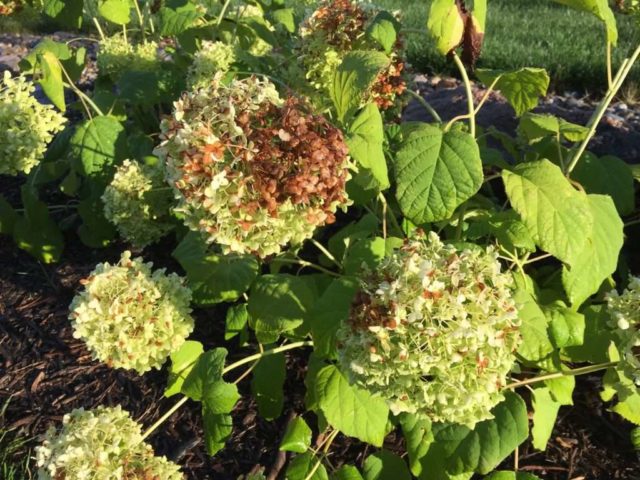
Bordeaux liquid will help to avoid the fungus, you need to spray the plant in early spring and during preparation for wintering
One of the enemies of the Pink Pinkushen tree hydrangea is the leaf aphid. It is a small pest, its average size is 5 mm. The insect eats the underside of leaves, tops of young shoots, buds. To combat it, insecticides are needed.
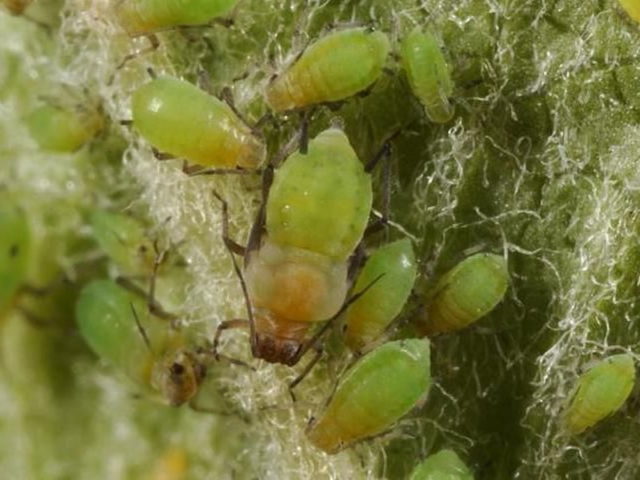
The color of the aphid corresponds to the plant on which it parasitizes
Another enemy of the plant is the spider mite. Even an adult pest is very small - its size is only 1 mm. The first sign of its appearance is the cobweb on the lower part of the leaves. It is very thin, almost transparent. White dots appear on the leaves, they dry out.
Acaricides, insectoacaricides help against spider mites. Prevention is regular weeding, feeding with potassium and phosphorus.
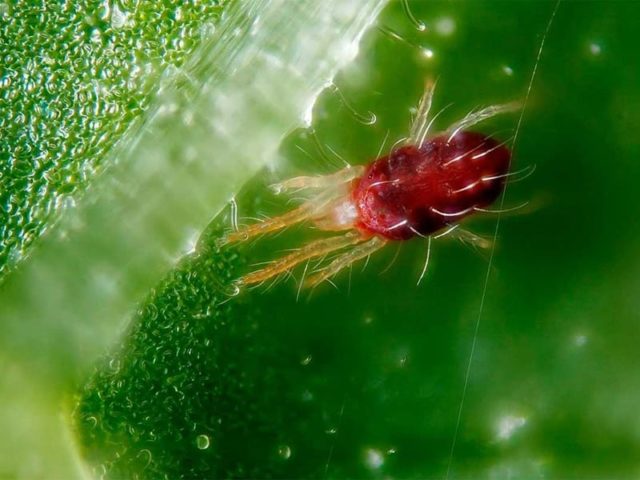
A good prevention of spider mites is an infusion of garlic for spraying
Conclusion
Hydrangea tree Pink Pinkushen is a beautiful and lush shrub that can be effectively used in landscape design. The plant is quite unpretentious, it is not difficult to grow it. Care should be comprehensive, the appearance and health of the plantings depend on it.
